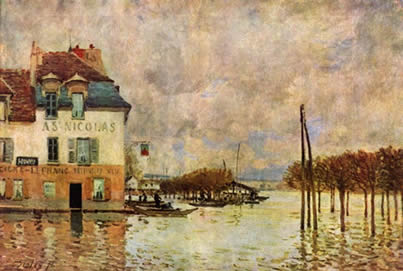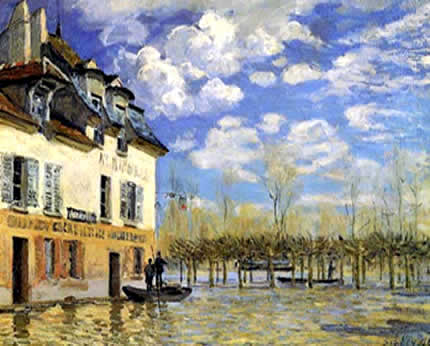After the flood: Alfred Sisley in Port-Marly

The floods in Port-Marly painted by Alfred Sisley
by G. Fernández – theartwolf.com
When talking about Impressionism, we often make the mistake of including in this movement some painters who had nothing or almost nothing in common with it -Rousseau, Redon-, or others who, despite having felt an early attraction to the new movement, soon rejected it -Paul Gauguin, Paul Cézanne- or even others who, though being generally considered as representative members of this movement, can not be called “pure impressionists”. In this last group, we have to differentiate between those who developed their style before the arrival of Impressionism – Edouard Manet- and those whose interests led them to search well beyond Impressionism -Edgar Degas, Pierre-Auguste Renoir-. If we want to look for the “pure”, essential impressionist painters, those who developed their impressionist style without interferences from any other style, the list -with the risk of use a dangerously simplistic purism- would be reduced to very few names: Claude Monet -the real Michelangelo of the impressionist era-, Camille Pissarro -the great chronicler of the rural life-, Berthe Morisot, and Alfred Sisley.
Alfred Sisley (1839-1899) was above all a landscape painter. Less gifted than Monet, and less ambitious than Pissarro, Sisley always felt an artistic attraction for river landscapes. In that sense, his unquestionable masterworks are a group of canvases, painted in 1872 and 1876, depicting the floods of the Seine River in the French town of Port-Marly.
Sisley painted several canvases depicting these floods in Port-Marly, but the two most outstanding examples are those showing the waters around a wine shop in Rue Paris. We must remark that several painters, for example Claude Monet, had already represented the floods of the Seine River, but Sisley was the first to depict this natural incident affecting inhabited areas. The horizon line, unusually low, closely resembles the views created by the artists from the Delft School and the views of Venice painted by Joseph Mallord William Turner, an artist whose works Sisley had the opportunity of admiring during a trip to London. Interestingly, the different views painted by Sisley have a similar composition: the buildings shown in the left area of the canvas divide the picture in two sections: at the left we can see the flood affecting the human and constructed environment, while natural and vegetal elements emerge from the waters at the right area of the composition.

Contrary to most paintings depicting natural disasters, Sisley did not include any explicitly tragic or heartbreaking element. We see neither demolished buildings, nor fallen trees, nor bridges dragged by the force of waters. The aspect of the sky, far from being threatening, is hopeful, with great blue spaces appearing among the clouds. The personages in the boats remind more of placid Venetians gondoliers than to scared neighbours trying to save their personal belongings from the force of the waters.
A precocious painter, member of a wealthy family, Alfred Sisley soon met the great impressionist painters of his era, and he was admitted in the Salon of 1866. However, his comfortable way of life was truncated in later years. The Franco-Prussian war of 1870 completely bankrupted his family, causing him to suffer financial hardship for the rest of his life. Rejected by Art galleries, only Durand-Ruel bought a few of his paintings. Thus, we can suggest a link between these paintings and the turbulent biography of their creator: it is possible that Sisley saw the floods in the quiet town of Port-Marly as a reflection of his own life, troubled, overflowed, after events as unforeseeable and inevitable as the floods of the Seine River.
Follow us on:
